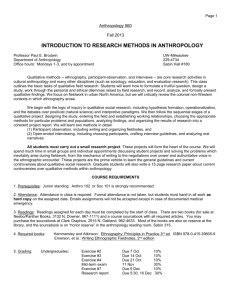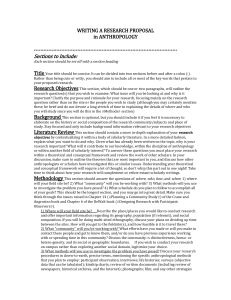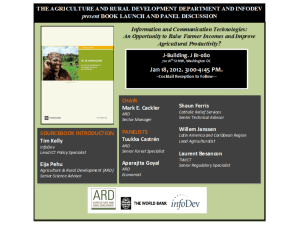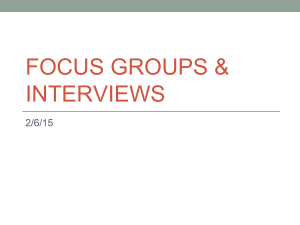introduction to research methods in anthropology
advertisement
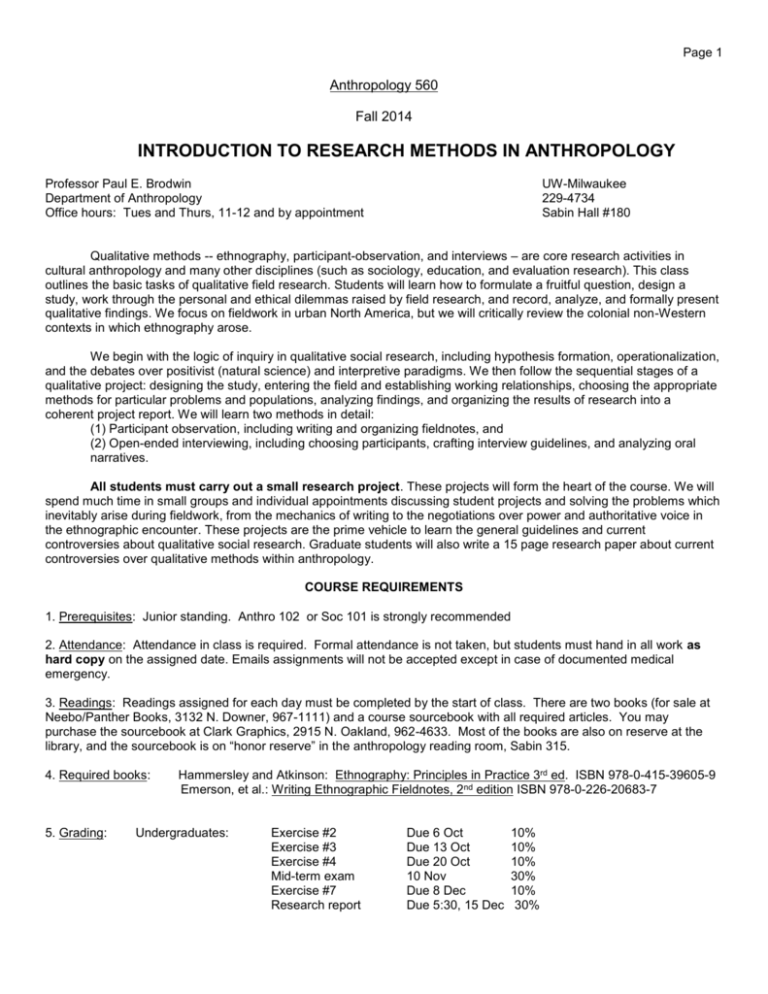
Page 1 Anthropology 560 Fall 2014 INTRODUCTION TO RESEARCH METHODS IN ANTHROPOLOGY Professor Paul E. Brodwin Department of Anthropology Office hours: Tues and Thurs, 11-12 and by appointment UW-Milwaukee 229-4734 Sabin Hall #180 Qualitative methods -- ethnography, participant-observation, and interviews – are core research activities in cultural anthropology and many other disciplines (such as sociology, education, and evaluation research). This class outlines the basic tasks of qualitative field research. Students will learn how to formulate a fruitful question, design a study, work through the personal and ethical dilemmas raised by field research, and record, analyze, and formally present qualitative findings. We focus on fieldwork in urban North America, but we will critically review the colonial non-Western contexts in which ethnography arose. We begin with the logic of inquiry in qualitative social research, including hypothesis formation, operationalization, and the debates over positivist (natural science) and interpretive paradigms. We then follow the sequential stages of a qualitative project: designing the study, entering the field and establishing working relationships, choosing the appropriate methods for particular problems and populations, analyzing findings, and organizing the results of research into a coherent project report. We will learn two methods in detail: (1) Participant observation, including writing and organizing fieldnotes, and (2) Open-ended interviewing, including choosing participants, crafting interview guidelines, and analyzing oral narratives. All students must carry out a small research project. These projects will form the heart of the course. We will spend much time in small groups and individual appointments discussing student projects and solving the problems which inevitably arise during fieldwork, from the mechanics of writing to the negotiations over power and authoritative voice in the ethnographic encounter. These projects are the prime vehicle to learn the general guidelines and current controversies about qualitative social research. Graduate students will also write a 15 page research paper about current controversies over qualitative methods within anthropology. COURSE REQUIREMENTS 1. Prerequisites: Junior standing. Anthro 102 or Soc 101 is strongly recommended 2. Attendance: Attendance in class is required. Formal attendance is not taken, but students must hand in all work as hard copy on the assigned date. Emails assignments will not be accepted except in case of documented medical emergency. 3. Readings: Readings assigned for each day must be completed by the start of class. There are two books (for sale at Neebo/Panther Books, 3132 N. Downer, 967-1111) and a course sourcebook with all required articles. You may purchase the sourcebook at Clark Graphics, 2915 N. Oakland, 962-4633. Most of the books are also on reserve at the library, and the sourcebook is on “honor reserve” in the anthropology reading room, Sabin 315. 4. Required books: 5. Grading: Hammersley and Atkinson: Ethnography: Principles in Practice 3rd ed. ISBN 978-0-415-39605-9 Emerson, et al.: Writing Ethnographic Fieldnotes, 2nd edition ISBN 978-0-226-20683-7 Undergraduates: Exercise #2 Exercise #3 Exercise #4 Mid-term exam Exercise #7 Research report Due 6 Oct Due 13 Oct Due 20 Oct 10 Nov Due 8 Dec Due 5:30, 15 Dec 10% 10% 10% 30% 10% 30% Page 2 Graduate students: Exercise #2 Exercise #3 Exercise #4 Exercise #7 Research report 15 page paper Due 6 Oct Due 13 Oct Due 20 Oct Due 8 Dec Due 5:30, 15 Dec Due 5:30, 15 Dec 10% 10% 10% 10% 30% 30% Graduate students must write a research paper: minimum of 15 FULL double-spaced typed pages, not including bibliography and title/abstract page. The topic must concern contemporary methodological debates in qualitative social research. Consult with the professor by 1 November about your topic. All examinations must be taken on the date stated in the syllabus. All exercises and papers must be handed in as hard copies by the stated due-date. No e-mailed exercises or papers will be accepted. Make-ups and extensions will be granted only for documented emergency situations and must be arranged at least 24 hours prior to the stated date of exam or due-date by contacting the professor (not the TA). Any person not making prior arrangements will automatically be given a grade of zero for that paper, exercise, or examination. Plagiarism also warrants a grade of zero. For further rights and responsibilities as a student, please consult www4.uwm.edu/Dept/SecU/SyllabusLinks.pdf. To maintain a good learning environment and to respect your fellow students, turn off all cell phones, Blackberries, etc. in class. Do not send or receive text messages in class. Personal computers are allowed only for taking notes. Using computers for other purposes (email or websites) will lead to a ban on computers in class. In general, auditors are welcome if space permits. During class discussions, however, I am responsible first and foremost to students enrolled for credit. I: INTRODUCTION AND RESEARCH DESIGN 8 Sept: 15 Sept: Introduction to course: Historical precursors: ethnography in British and American social science Conceptual dilemmas: positivist vs. interpretive research The logical structure of qualitative research A. Controversies over method READINGS: Hammersley: chap. 1 Silverman, chap. 2 (sourcebook) B. Researcher as outsider READINGS: Schutz: The stranger (sourcebook) Rose: Inquiry and epiphany (sourcebook) Exercise #1: The setting for local research (Due 22 Sept) 22 Sept: Research design A. Problem, setting, and sample READINGS: Hammersley: chap. 2 B. Generating a local research problem READINGS: Silverman: chaps. 1 and 3 (sourcebook) Small groups meet to discuss exercise #1 Exercise #2: Social map/initial observations (Silverman p. 43) (Due 6 Oct.) 29 Sept: Ethnography and the discipline of anthropology A. Classic text and a modern critique READINGS: Malinowski: Subject, method and scope (sourcebook) Geertz: I-witnessing: Malinowski’s children (sourcebook) B. Film: “A Balinese Trance Séance” Page 3 6 Oct: Entering the field: a political and subjective engagement A. General guidelines READINGS: Hammersley: chaps. 3-4 Wolcott, chapter 5 Hand in Exercise #2 B. Small groups meet to discuss Exercise #2 and begin … Exercise #3: Develop foreshadowed problem (Due 13 Oct.) II: PARTICIPANT OBSERVATION 13 Oct: Overview of participant-observation research A. Ethical issues READINGS: Hammersley, chap. 10 Wolcott, 6 (sourcebook) Code of Ethics of the American Anthropological Association B - Discuss and make short revisions to foreshadowed question - How and why to take fieldnotes READINGS: Hammersley: chap. 7 Emerson et al: chaps. 1-2 Hand in Exercise #3 Exercise #4: Plan for local participant-observation research (Due 20 Oct) Begin your field research! 20 Oct: Two models for “writing up” participant observation research A. Ethnographer as observer (and analyst) READINGS: Duneier: Sidewalk (excerpts) (sourcebook) B. Ethnographer as a protagonist (and analyst) READINGS: McLean: When the borders of research and personal life become blurred (sourcebook) Exercise #5: Continue your participant observation research (Preliminary fieldnotes, 15 page minimum, due in the Appendix of the final report) III: INTERVIEWING 27 Oct: Planning the research interview A. From participant-observation to interviewing READINGS: Hammersley: chaps. 5 and 7 B. Case study: How to write a research interview READINGS: Martin: chapters 1-2 and Appendix 1 (sourcebook) Exercise #6: Prepare list of interview questions (first draft due 3 Nov) 3 Nov: Guidelines for effective interviews A. READINGS: Kvale, from “InterViews” chaps. 5-8(sourcebook) Bernard: Chap. 10, Unstructured and Semi-structured Interviews (sourcebook) B. FILM: “Maid in America”, and in-class exercise of note-taking from interviews If time permits: small group work to review your interview guide Exercise #7: Conduct and write up interviews (due 8 December) 10 Nov: A. UNDERGRADUATE MID-TERM EXAMINATION No second half of class. You may leave after finishing the mid-term exam Page 4 17 Nov: Writing up fieldnotes and interview notes A. Fieldnote mechanics: recording and analyzing interviews READINGS: Emerson et al.: chaps 3, 4 and 5 B. Small group work In-class writing exercise. Writing up fieldnotes (a) sketch of place and routines (b) dramatic episode (c) characterization 24 Nov: Core skill of ethnographic writing: how to make small details address large questions A. Samples from text READINGS: Scott: Excerpt from Domination and the Arts of Resistance Brodwin: Ethics of Ambivalence… B. Bring extract of your participant observation and/or interview Small group work:. Make it speak to larger issues, foreshadowed questions and conceptual problems. 1 Dec: A. Analyzing your data and making sense of the project READINGS: Hammersley and Atkinson: chapter 8 and 9 Emerson: chapter 6 In-class coding exercise, using community psychiatry fieldnotes B. Community reactions to published ethnography READINGS: Scheper-Hughes: Ire in Ireland 8 Dec: Hand in Exercise #7: write-up of interviews Presentation of research results. Volunteers will summarize their project and findings, and then the room will provide consultation about how to connect foreshadowed problem, participant observation results, research interviews, and life-history interviews into a single text. 15 Dec: Official final examination date. RESEARCH REPORTS DUE: 15 December Turn in all papers by 5:30 pm under my door: Sabin Hall 180, 3413 Downer Ave Please mark your status as major or non-major. Graduate papers due at same time & place **************************************************** For first week: Historical precursors From W.H. Rivers (1913) The essence of intensive work…is limitation in extent combined with intensity and thoroughness. A typical piece of intensive work is one in which the worker lives for a year or more among a community of perhaps four or five hundred people and studies every detail of their life and culture; in which he comes to know every member of the community personally; in which he is not content with generalized information, but studies every feature of life and custom in concrete detail and by means of the vernacular language. It is only by such work that one can realize the immense extent of the knowledge which is now awaiting the inquirer, even in places where the culture has already suffered much change. It is only by such work that it is possible to discover the incomplete and even misleading character of much of the vast mass of survey work which forms the existing material of anthropology. W. H. Rivers, “Report on anthropological research outside America.” In: The Present Condition and Future Needs of the Science of Anthropology, presented by W.H. Rivers, A. E. Jenks, and S. G. Morley, Washington, DC, 1913, p. 6. Quoted in Adam Kuper, Anthropology and Anthropologists: The Modern British School. London: Routledge and Kegan Paul, 1983, p. 7. Page 5 Instructions for written exercises, with required length (11 point type, double space) I. Research Design Exercise #1 The setting for local research : 5 full pages Write a list of three organizations, communities, or stable groups in which you already participate or could easily begin to participate. Examples include religious congregations, hobby clubs, special interest groups, sport clubs, etc. For each group, answer the following questions: - How often does the group meet as a whole? - What opportunities exist for participant observations or background observations? - What opportunities exist for formal interviewing? - What are the topics of collective debate and concern? That is, what issues are predictably discussed by people from this group? - What issues are relevant to the group but passed over in silence? Could participant observation address these issues? Exercise #2 Social map/initial observations (adapted from Silverman p. 43, boxed exercise): 5 full pages This is a research exercise to improve your observational skills. 1. Select a setting in which you regularly participate or could easily join. It should be one of the 3 organizations discussed in exercise #1 2. Make a sketch map of the site. This should be a one-page visual map, using pencil or pen, NOT a prose description. Do not use a computer; draw it freehand. This map should show the relevant social uses of the space. 3. In prose, describe what sort of activities the physical lay-out encourages or discourages. See Silverman’s examples Stimson’s comparison of the room for medical hearings and MacDonald’s. How do people use the space you are studying? What do they show they are attending to? How do they communicate with one another or avoid communication? Do they look at one another or avoid it? What distance do they keep between one another? 4. In what ways are people using the space to co-operate with one another to define themselves (e.g., as a restaurant crowd but not bus passengers)? 5. Is there any difference between how people organize their activities when they are on their own, in pairs or in a crowd? 6. How do people use the setting as a resourse for engaging in activities not specifically intended (but not necessarily inappropriate) in that setting (e.g., displaying particular personal characteristics such as wanting to communicate or not wanting to communicate)? Exercise #3 Foreshadowed problems: 5 full pages Develop at least two foreshadowed problems, tailored to your chosen setting. For each foreshadowed problem, answer the following questions: 1. How did you arrive at this problem? (As needed, refer to your previous life experiences, your initial knowledge or experience of the setting, ideas from other courses, etc.) 2. Is this problem relevant to insiders from your setting? Why or why not? 3. Brainstorm about the types of information you will need to address this problem (what and where to observe, who to speak with, what questions to ask, what life-history data might be relevant) Page 6 II. Participant Observation Important: For all remaining exercises, write your foreshadowed problem at the top of first page! Exercise #4 Methodological plan for local participant observation research: 5 full pages Given your foreshadowed problem, decide in advance what types of participant observation research you will need to investigate them. - In what manner will you participate with group members? - Do you need to secure special permission from “gatekeepers”? - How will you present your identity and research mission to group members? - How much participant observation is needed (days, weeks, episodes)? - Are there special rituals, ceremonies, or vantage points that you should cover? - How and when will you record your fieldnotes? - When will expand and elaborate your fieldnotes? III. Interviewing Exercise #6 List of interview questions: In the manner of Emily Martin, specify 3 - 5 major topics for your interviews and then devise list of specific questions. You must have at least 20 discrete questions. You should also write about the following issues (at least 3 pages): - What background information do you need for each respondent? Why? - Will you use the same list for everyone, or do certain groups of participants require different approaches and questions? - In what setting(s) will you interview people? - How will you choose who to interview? - How will you document the interview? (Will you take notes at the time or record it from memory afterwards?) Exercise #7 Write-up of interviews: 15 full pages Choose several thematic questions that address your foreshadowed problem, and address each question by providing (a) relevant raw interview data and (b) interpretations of raw data. You can choose the precise format for this write-up, drawing on course readings. However, you must present the following: - questions that you asked - people’s responses in their own words - the range of people’s responses, if you conducted several interviews using the same guide - your own interpretations, which show how people’s responses address your general foreshadowed questions. IV. Preparing the Research Report (at least 15 full pages, not including appendices) Objectives: Imagine that you received a grant to conduct this research, and that you must now tell the grants officer how you spent the money. The research report should summarize why you conducted the research, what methods you chose and your justification for these methods, what your main findings are, and how you interpret these findings. Because the report is written for a grants officer, not an academic journal, you should focus specifically on the course and outcome of research. Do not try to explain its larger theoretical importance, its relevance for other researchers, or its policy implications. As an assignment for this class, the most important part of the report are the final three sections (see below), since you have already written about sections I, II, and III. However, do not simply cut and paste from earlier assignments! Revise as necessary, given the changing direction or scope of your research project. So, you may need thoroughly to rethink the initial sections. Page 7 Outline: Your research report should have six sections: Title of project I. Background to research II. Foreshadowed problem III. Setting and Methods IV. Main empirical findings V. Interpretation VI. Summary and suggestions for future research VII: Appendix. Must include exercise #5 (preliminary fieldnotes). I. Background to research: What were the overarching research themes that drove you to undertake this project? These could be theoretical controversies in anthropology or other social sciences, issues of importance to particular communities or social groups, etc. II. Foreshadowed problems: What were the main problems that you addressed? If more than one, discuss which ones proved most fruitful. Did they change in the course of research? Can you develop some “accommodative hypotheses” on the basis of this research? III. Setting and Methods: Succinctly summarize how and where you carried out the research. Briefly describe the setting(s), the nature of participant observation and interviews, and the time-frame of research. Summarize the number of people interviewed and their relevant demographic characteristics. If you would like to Include your interview schedule and guidelines for participant observation, you may put these in the appendix, but these items are not required to appear in the your final report. IV. Main empirical findings. What did you find out that is relevant to your hypothesis or research question? For your participant observations, summarize the main contours of social life in your setting. For your interviews, summarize the main themes that emerged in people’s talk. You may wish to break this into down main and secondary findings. To write this section, you must evaluate which data speak directly to your hypothesis, and which are relevant but in more oblique ways. V. Interpretation: How do your main findings address your foreshadowed problem or research questions? Do they prove your hypotheses correct or incorrect? Do they push the research questions in another direction? Use this section to discuss what new knowledge your research generated. How does your research address the general questions raised in section I? What contradictions did you uncover in the course of research, and how would you resolve them? VI: Summary and suggestions for future research. Does your research suggest other hypotheses and other approaches for future fieldworkers interested in the same questions? What questions remain that you could not explore due to limitations of time, money, access, etc.? Page 8 Maid in America, a documentary film by Anayansi Prado, an Impacto Films Production (2004). This documentary that explores the lives of Latina immigrant women who work as nannies and housekeepers in Los Angeles, CA…. - Telma, a Salvadorian immigrant nanny and Mickey, her employers’ 6 year-old boy - Eva, a 37 year-old woman with a BA in accounting from Mexico, who works temporarily as housekeeper, as she waits for a better job. Foreshadowed problem: How much “social distance” separates housekeepers and their employers? Can they possibly understand each others’ motives and the different social worlds they each occupy? Research questions: (1.) What are these women’s motives for working as housekeepers? What are their employers’ motives for hiring them? Is there any overlap between the two? (2.) What are the costs and benefits about working in the US, from the housekeepers’ point of view? What are the costs and benefits about hiring these women, from the employers’ point of view? Interview questions: No. 1. (5:18 to 7:13) To Eva: Did you come to the United States wanting to be a housecleaner? Are you trying to get a different job? No. 2. (8:24 to 9:24) To employers of Telma: what are the key issues about hiring a nanny? No. 3. (11:38 to 14:11) To Eva: What is the most difficult thing about being a maid in the US? No. 4. 32:50 to 35:27) To employers of Telma: why did you hire a child care worker? Did you ever regret hiring her? Are there any drawbacks? Analysis of ethnographic interviews: 1. Take notes on interviews. 2. Expand your notes. a. Fill in as much verbatim transcript as possible. b. Write paraphrases, where you cannot recall verbatim talk. 3. Make your data answer the research questions. a. Re-read the questions. b. Underline segments of transcript that are relevant to each question. c. Write a one-paragraph answer to each question. Your answer should draw from and interpret the interview data. 4. Address the foreshadowed question. a. Review your answers to the research question. b. Building from your answers, write a one-paragraph reflection about social distance and the diverse motives and life-worlds of housekeepers and employers.
